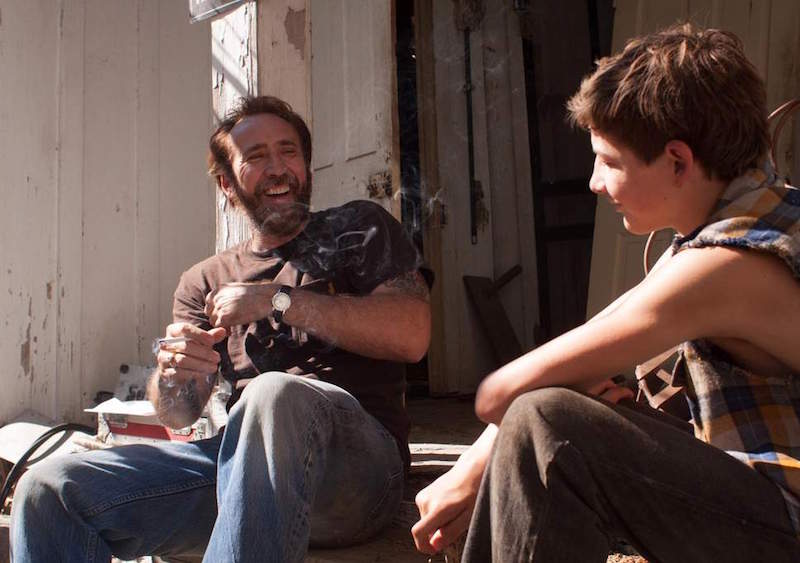Synopsis: Ten years ago, tragedy struck the Russell family, leaving the lives of teenage siblings Tim and Kaylie forever changed when Tim was convicted of the brutal murder of their parents. Now in his 20s, Tim is newly released from protective custody and only wants to move on with his life; but Kaylie, still haunted by that fateful night, is convinced her parents’ deaths were caused by something else altogether: a malevolent supernatural force — unleashed through the Lasser Glass, an antique mirror in their childhood home. Determined to prove Tim’s innocence, Kaylie tracks down the mirror, only to learn similar deaths have befallen previous owners over the past century. With the mysterious entity now back in their hands, Tim and Kaylie soon find their hold on reality shattered by terrifying hallucinations, and realize, too late, that their childhood nightmare is beginning again…
Release Date: April 11, 2014 MPAA Rating: PG-13
Genre(s): Horror,
Film Review

Production
For the past couple of years, April has been a banner month for horror movies. It seems as if Hollywood has been blasting away the drudge of bad winter films by releasing the best horror films of the year right at the break of spring. A couple of years ago, audiences were treated to Cabin in the Woods, and last year they got Evil Dead. The pattern continues this year with Oculus.
Oculus is the story of a cursed mirror called the Lasser Glass that has been responsible for 45 deaths in the 4 centuries of its existence. Kaylie Russel (Karen Gillan from “Doctor Who”) and her family last owned the mirror, and her parents (played by Katee Sackhoff from “Battlestar Galactica” and Argo‘s Rory Cochrane) ended up murdered while her brother, Tim (Brenton Thwaites from “Home and Away”), took the blame. Tim was sent to a mental institution and, upon his release, he learns that Kaylie has purchased the Lasser Glass from an auction house with the intent of studying it to prove Tim’s innocence. After Kaylie gets the proof she needs to exonerate her brother, she intends to destroy the mirror. Tim reluctantly agrees to help, and the pair hangs the mirror up in their old house, sets up a bunch of cameras to document their findings, and begins their scientific study of the glass. However, they quickly figure out that the mirror has plans of its own.
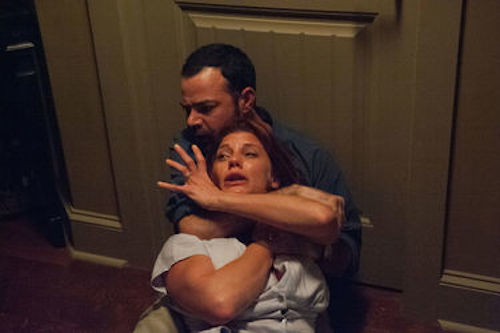
Jason Blum’s Blumhouse Productions has brought some of the greatest horror movies of the last decade to the screen, including the Paranormal Activity franchise, the Insidious movies, Sinister, and The Lords of Salem. It really comes as no surprise that Oculus is a Blumhouse production; it has all of the makings of a modern horror classic. Writer/Director Mike Flanagan has crafted a maddeningly suspenseful tale that blends the supernatural and the psychological, and does it in a way that is fresh and exciting. And damn scary.
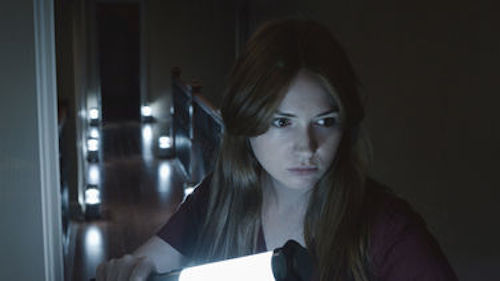
The thing about Oculus that really sets it apart from other films is how effortlessly it plays with alternate timelines. The narrative jumps back and forth between the present and the past, flipping from the adult Kaylie and Tim dealing with the mirror to the younger Kaylie and Tim (played by Standing Up‘s Annalise Basso and Insidious: Chapter 2‘s Garrett Ryan) watching their parents try to cope with it. As if that weren’t enough, the mirror has the power to make its victims hallucinate, which tosses another additional timeline into the mix – what’s real and what’s imagination. There is a fun tension between true believer Kaylie and skeptic Tim that comes out, especially when they take a look at the tapes that they have been making and are shown something completely different from what they both remember happening. It may sound confusing, but the flip-flopping of time and memory is handled so well that it makes perfect sense; it flows.
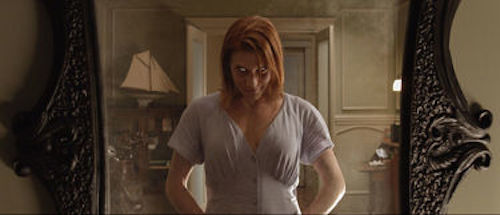
Oculus is unusual for another reason as well, and that is the mirror. The Lasser Glass is the antagonist of the film, and it’s a formidable one at that. Mirrors are great props in horror movies, and the convention of being surprised at what is staring back is used in Oculus, but The Lasser Glass is much more than that. This mirror’s gruesome history is revealed by Kaylie in a bit of rudimentary exposition for her cameras, but her vocalizing the curse puts it into her and Tim’s heads at the same time. Once it has entered their minds, the Lasser Glass seems to become an animate being, controlling Kaylie and Tim and pitting them against each other and the rest of the world. The Lasser Glass is more than just a prop or piece of set dressing; it’s another character, and a it’s huge part of what makes Oculus so much fun…and frightening.

Writing
The screenplay for Oculus has been masterfully and meticulously planned out with no stone left unturned nor any detail left to chance. Mike Flanagan and Jeff Howard (Somnia) fleshed the script out from a short film that was written by Flanagan and Jeff Seidman (more accomplished as a reality show editor for shows like “Dirty Jobs”) called “Oculus: Chapter 3 – The Man with the Plan.” The storyline drifts between the past and present, and the two timelines are interwoven seamlessly. What appears onscreen is a surreal mixture of real and imaginary, with the viewer sometimes being unsure of what is actually happening and what is being dreamed up by the characters. It sounds like it would be confusing to watch, but the way that Flanagan and Seidman lay out the timeline makes perfect sense. The audience is let in on the trick, but they’re also along for the ride. It’s not quite as slick as, say The Butterfly Effect, but the way the timelines shift and drift is along the same lines. It’s a script that works wonderfully, but should not be used as an example for novice screenwriters; they might hurt themselves if they try that at home.

Score and Soundtrack
The musical score for Oculus was provided by Andy and Taylor Newton, professionally known as The Newton Brothers (Pawn Shop Chronicles). The soundtrack goes a long way towards creating the feeling of dread and suspense that is all over the film. The music is a sparse mixture of creepy instruments like violins, basses, and pianos that pulse away into a wonderful crescendo buildup until the viewer just can’t take it anymore. The Newton Brothers also know the value of silence, and they let the absence of music do the talking at times, which provides even more tension. Oculus is built on the creation of a creepy and dreadful environment, and The Newton Brothers’ score is a terrific compliment to the film.

Scary Factor
There are a ton of great, scary moments in Oculus. Like the Paranormal Activity movies, much of the fear is generated by the slow and deliberate buildup of tension and suspense. For example, in one early scene as Kaylie is picking up the mirror to bring it to the house, she sees a trio of sheet-covered statues behind her in the warehouse. When she turns around, there are only two. She checks the mirror again, and there are three. It’s a wonderfully effective scene, teetering on the brink between playful and horrifying. There are several cringe-worthy gore effects and implied violent scenes as well; at one point Kaylie is eating an apple and changing light bulbs at the same time (mental note – don’t do that) and the spirits get her to mix them up, and in another scene a character is picking at a band-aid on his finger with a staple remover only to find that the band-aid is sitting on the desk and his finger is a bloody pulp. The one type of scare that is not plentiful in Oculus is the cheap jump scare – there aren’t many of them, and the film doesn’t need them. There’s plenty to be afraid of in the film without tricking the audience into screaming.
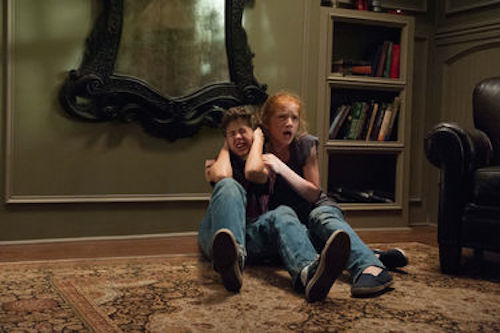
Cast and Crew
- Director(s): Mike Flanagan
- Producer(s):
- Screenwriter(s): Mike FlanaganJeff Howard
- Story:
- Cast: Karen Gillan (Kaylie Russell)Brenton Thwaites (Tim Russell)Katee Sackhoff (Marie Russell) Rory Cochrane (Alan Russell)James Lafferty (Michael Dumont)Katie Siegel (Marisol Chavez)
- Editor(s): Mike Flanagan
- Cinematographer: Michael Fimognari
- Production Designer(s):
- Costume Designer:
- Casting Director(s):
- Music Score:
- Music Performed By:
- Country Of Origin: USA
